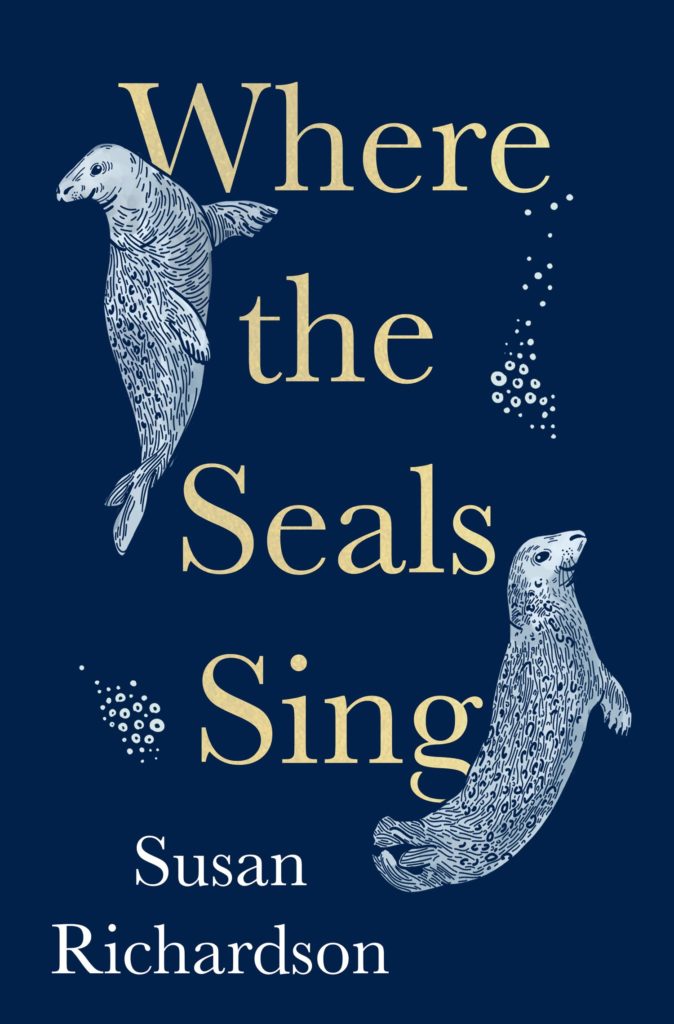In ‘Where the Seals Sing’, published yesterday by Harper Collins, poet Susan Richardson travels the coasts clockwise from Cornwall to Norfolk, tracing the rhythm of grey seal lives. In doing so, she asks questions of the ethics of care in its manifold dynamics — from human to animal to parent to public and back again, writes Abi Andrews.

Grey seals are the UK’s largest land-breeding mammal, besides humans. They are our megafauna, and they have a mythic pull on us, with their uncanny voices and their ‘soul seeking’ eyes. Visiting the UK’s grey seal hotspots clockwise around the coasts, from Cornwall to Norfolk, in Where the Seals Sing we join poet Susan Richardson on a journey centring British seals. The exploration is spirited and varied, undertaken via seal observation, advocacy and research, selkie myth, and including a bit of seal-shapeshifting via a visit to a shamanic healer. In writing that’s trim and unshowy (‘a perfect, unrippled reflection flies beneath its cormorant’), Richardson cuts to the heart of things, seeking some comfort and familiarity in the stoic persistence of seal life, against the personal struggle of her dad’s cognitive unmooring at the onset of dementia.
Much of household British ‘animal writing’ was written at a time when ethics towards wild animals were very different. They recount intense and wondrous human-animal interactions that we read with both envy and trepidation, aware as we are that these encounters, which happened under duress of the wild animal, were mired by hidden violence and heartbreaking consequences (beloved Ring of Bright Water being just one poignant example). Contemporary accounts will never be as wondrous, precisely because they were always unreal. Our current ethics towards wildlife are rightly focussed on animal needs, leading to strict policies around ‘humanising’ — essentially banning those interactions with wild animals we nostalgically crave. That discomforting tug between restraint and desire is at the centre of this book.
But this change hasn’t filtered down to everyday human-seal interactions, as Richardson finds. Her frustration simmers, teetering towards misanthropy; it seems every person who has gone to see the seals is a caricature of ignorance. Perhaps this is justified, to the extent that humans endanger seals with their insatiable desire to interact. The unintentional distress from just coming too close can upset a seal’s digestion and impact energy reserves, affecting their survival.
Would we all behave so badly if we knew the full impact of our actions? For the optimist, Richardson’s chiding (which can also read as wry humour) is a little persistent at times. But even the optimist falters at the issue of those who intentionally harass seals, like some that will cause a seal colony to stampede with video drones and sell the footage. And in all human-seal meeting points Richardson visits, it is our desire for interaction, or our unquestionable right to walk our dogs where we want to, that always overrides animal welfare, even as the law tells us differently. In the words of one pro-seal interviewee: “Everyone says we’ve got to encourage interaction to make people care about the natural world, but we’ve created a monster because now people want to interact at all costs”, (think of tiger farms, dolphins suffocating for Instagram).
Hope is found in the seal advocates, the ones volunteering their time teaching sealsaving manners and etiquette to beachgoers who will inevitably encounter seals. But the sense is the pedestrian crowds are a relentless disruption, that it falls on a few volunteers and campaign groups to educate — essentially using their bodies to dam a flood when what is needed is a thorough change of respect towards the nonhuman and their right to peaceful existence in and of itself. It’s easy to share in the frustration; our lack of manners belies a persistent superiority, one that led us to this unfolding biodiversity crisis. Seals and other animals don’t have time to patiently wait for us to learn some manners. The wait is costing them their lives.
There are further coin-sides for Richardson to grapple with. The places where we meet the seals, the boat tours and the shared beaches, create new advocates, new arenas for empathy, even as they sometimes disturb seals. They bring people into a camaraderie with seals they come to know as their ‘own’, and as part of an expanding sense of this camaraderie comes recognition: ‘it strikes me that the laughter at the snorting and the farting is displaced embarrassment at our own messy and recalcitrant bodies, a subconscious and perhaps uncomfortable realisation that we too are animal’. At these interfaces there will always be both: the people ‘who’d rather be at Alton Towers’ and others ‘in tears because they’re so moved’ by the encounter. These spaces can foster our capacity to care.
Where the Seals Sing asks questions of the ethics of care in its manifold dynamics, which flow from human to animal to parent to public and back again. When should interventions come? Freedom at what costs? At which point do ‘nannying’ tendencies slip from caring to overbearing? The foregrounding of care-relations situates Richardson as a writer embroiled in the webs she writes from. They implicate her writerly project, which is constantly reconfigured by her worrying about her dad in a way that’s honest and tender and makes for richer reading. Richardson keeps returning to her home seals on the Pembrokeshire coast. Her persistence and patience on respectful observation of her seals mirrors relations with a loved-one undergoing a deteriorating mental state — the sometimes frustration, sometimes rupturing confrontation, sometimes elation, that both entail.
*
‘Where the Seals Sing’ is out now and available here (£20.00).